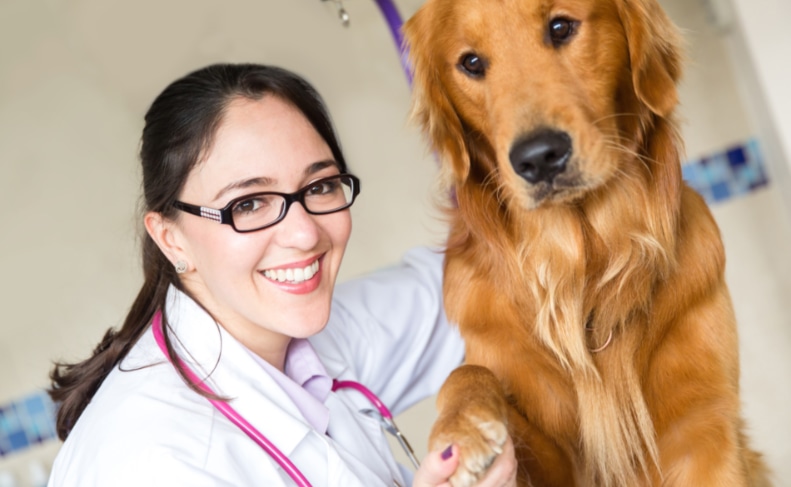Hip dysplasia in dogs – Caring and Curing
1. Introduction
Hip dysplasia is the most common bone and joint disease in dogs. It is a disease typical of dogs of large and medium breeds, less frequent in small breeds.
It presents with a poor congruence of the acetabular cavity (hip) with femoral heads that may appear dislocated or subluxated, that is, outside its natural place. The head of the femur does not have a good coating “dance” and this causes stress, inflammations and weakens the joint and periarticular tissues.
Degenerative changes of osteoarthrosis often occur . The osteoarthrosis that appears due to the dysplasia will cause the problems of inflammation, pain, which in turn will cause the dog to carry more weight in the hands, less in the posterior ones, reducing the muscular activity of these and generating muscular atrophy in the third Which will aggravate the symptoms.
2. Symptoms
The symptoms vary a little depending on the breed and above all the age of the dog. Diagnosis is usually made in distraction, ie with the dog lying up and symmetrical traction in the hind limbs, usually with the dog anesthetized or very sedated. The symptoms are not always related to the result of the X-ray.
Sometimes we see dogs with a lot of dysplasia and that they present little pain or even nothing and also the opposite, much pain with a result in the not so bad radiological exploration. The pain depends more on inflammation of the joint (synovitis) among other factors than the dysplasia itself.
Starting at 5 or 6 months, the warning signs start, the dog stops badly (pulls one leg out), has difficulty standing, does not carry weight in the hind legs, may have signs of pain after exercise , Slip, fall and present the typical gait of the dog with dysplasia which is the swinging of the back and running like a rabbit, ie advancing the two hind legs at the same time. Other behaviors may also be observed, such as sudden mood swings, becoming more aggressive, and shunning the owner’s presence. Sometimes at the end of growth the symptoms disappear or are greatly minimized, leaving only the clear sign in the swinging.
Hip dysplasia has clear indexes of heritability, although dogs are often carriers but do not develop it. Both environmental factors such as rapid development and nutrition as well as genetic factors influence. We can see children with hip dysplasia of normal parents and even viceversa, although given the high risk of transmitting the disease to the offspring one should not have to raise sick parents.
3. Prevention
Excess weight and an unvaried diet are factors that have been shown to increase your chances of getting the disease. The most critical period of development of this disease is between 3 and 8 months, reducing caloric intake and regular exercise without much impact could be an interesting decision to avoid hip dysplasia at this stage.
In older dogs, problems are determined as a consequence of the arthrosis they present. The most typical symptoms are the difficulty to get up, the swinging of the hips, the load of much more weight in front of the foot, helping with the previous limbs (rowing rather than propelling), visible difficulties to get on the hind legs, climb stairs, enter To the car or to the sofa. The typical position adopted by a dog with osteoarthritis of the hip is with the legs open to increase the base of support and the head forward to load more weight in the anterior part. You can also see the muscular atrophy that exists in the posterior ones.
Sometimes it is observed that they present lameness that disappears after walking a brief period of time, that suffer more in the morning when rising, especially if it has not rested properly or on a suitable mattress , and that the limbs usually place them flexed While walking, performing short steps as they hurt the extension of the hips and present a reduction of muscle mass of the posterior (atrophy) very important. The times of the walks are greatly reduced, the dog sits or lies down and does not want to go for a walk or for much during the walk.
Although there are different classifications, the International Dog Federation is based on this classification:
- No signs of dysplasia.
- Hip joints almost normal.
- Light dysplasia.
- Moderate or average.
- Serious.
4. Treatment
Although there are surgical methods: pectinous muscle excision, triple hip osteotomy, femoral head arthroplasty, forage, hip prosthesis … in the end the treatment is purely palliative. Methods included in pharmacology would be: anti-inflammatory and cartilage protectors.
Physical therapy also helps a lot to better develop the muscles without pain to remove tensions and eliminate compensations that the dog has performed.
We can help our dog with hip dysplasia in many ways. It is highly recommended reducing the load on the hip either by reducing the weight of the animal or helping us a wheelchair , moderate exercise and above all regularly. Physical exercise
Will help us a lot to improve muscle mass that will better withstand poor joint congruence. Physiotherapy and massage allow to always have the dog in a correct muscle state. Cartilage protectors to delay the onset of osteoarthritis and anti-inflammatory drugs prevent or reduce pain like CHONDROPAW.
It is also very advisable to protect the cold joint with thermal blankets or a hip support and in case the dog has difficulty getting up help with a harness for later . It is important for the dog to feel comfortable and to encourage him to move and exercise .
It is advisable to also sleep in a dog bed with viscoelastic and do not expose the dog to cold or high humidity.

